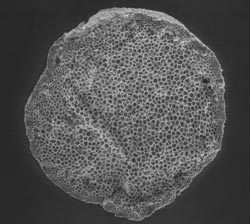Comet cause for climate change theory dealt blow by fungus

Specimen from Arlington Canyon, Santa Rosa Island, California, U.S.A.. (12,800-13,100 cal BP), section through spherule.<br>
Theories of impacts and their influence on animal extinctions and climate change are receiving increasing attention both in the scientific and popular literature. Despite increasing evidence to dispute the theory, the idea that onset of the Younger Dryas (‘Big Freeze’) climate interval, mega-faunal extinctions, including mammoths, the demise of the North American Clovis culture, and a range of other effects, is due to a comet airburst and/or impact event has remained alive both through written and television media despite growing negative scientific evidence.
One key aspect of this claim centers on the origin of ‘carbonaceous spherules’ that purportedly formed during intense, impact-ignited wildfires. Theorists have used these ‘carbonaceous spherules’ as evidence for their comet impact-theories, but this new study concludes that those supposed clues are nothing more than fossilized balls of fungus, charcoal, and fecal pellets. These naturally-occurring organic materials also date from a period thousands of years both before and after the Younger Dryas period began, further suggesting that there was no sudden impact event.
The research team examined organic residues from some of the proposed sites to investigate the nature of these organic spheres and ‘carbon elongates’ that ranged in size from ½ to 2mm (1/10 inch).
Samples from Pleistocene-Holocene sedimentary sequences in the California Channel Islands and other sites show that carbon spherules and elongate forms are common in samples dating to before, during, and well after the 12,900-year time horizon, including from modern samples. Professor Scott says, “Importantly, we were able demonstrate that these organic spheres were found commonly in both modern and ancient sediments and were not just restricted to any particular layer”.
The researchers undertook a series of microscopic studies, including using the advanced Swiss Light Source to probe their internal structure using Synchrotron Radiation X-ray Tomographic Microscopy (SRXTM) to show that carbon spherules have morphologies and internal structures identical to fungal sclerotia (such as Sclerotium and Cenococcum). In investigating these objects, Professor Scott commented: “These spherules had been commonly seen by researchers but little attention was paid to them and so few images existed in the literature. Perhaps it is not surprising that they have been misidentified. Some of the elongate forms described in other pa pers by the impact supporters are arthropod fecal pellets, some almost certainly from termites”.
Professor Scott points out that “we should always have a skeptical attitude to new theories and to test them thoroughly and if the evidence goes against them they should be abandoned”. Professor Pinter, one the report’s authors, from Southern Illinois University, adds, “I think we have reached that stage with the Younger Dryas impact theory”.
The paper, entitled ‘Fungus, not comet or catastrophe, accounts for carbonaceous spherules in the Younger Dryas ‘impact layer’, is published in the journal ‘Geophysical Research Letters’.
Notes to Editors
For further information contact: Simon Doyle, Senior Press and Communications Officer, Royal Holloway, University of London, 01784 443967; simon.doyle@rhul.ac.uk
Professor Scott co-authored the paper with:
N. Pinter (Southern Illinois University), M.E. Collinson, M. Hardiman (Royal Holloway University of London), R.S. Anderson (Northern Arizona University), A.P.R. Brain (King’s College, London), S.Y. Smith (University of Michigan), F. Marone and M. Stampanoni (Swiss Light Source, Paul Scherrer Institut, Switzerland).
Media Contact
More Information:
http://www.rhul.ac.ukAll latest news from the category: Physics and Astronomy
This area deals with the fundamental laws and building blocks of nature and how they interact, the properties and the behavior of matter, and research into space and time and their structures.
innovations-report provides in-depth reports and articles on subjects such as astrophysics, laser technologies, nuclear, quantum, particle and solid-state physics, nanotechnologies, planetary research and findings (Mars, Venus) and developments related to the Hubble Telescope.
Newest articles

Properties of new materials for microchips
… can now be measured well. Reseachers of Delft University of Technology demonstrated measuring performance properties of ultrathin silicon membranes. Making ever smaller and more powerful chips requires new ultrathin…

Floating solar’s potential
… to support sustainable development by addressing climate, water, and energy goals holistically. A new study published this week in Nature Energy raises the potential for floating solar photovoltaics (FPV)…

Skyrmions move at record speeds
… a step towards the computing of the future. An international research team led by scientists from the CNRS1 has discovered that the magnetic nanobubbles2 known as skyrmions can be…





















